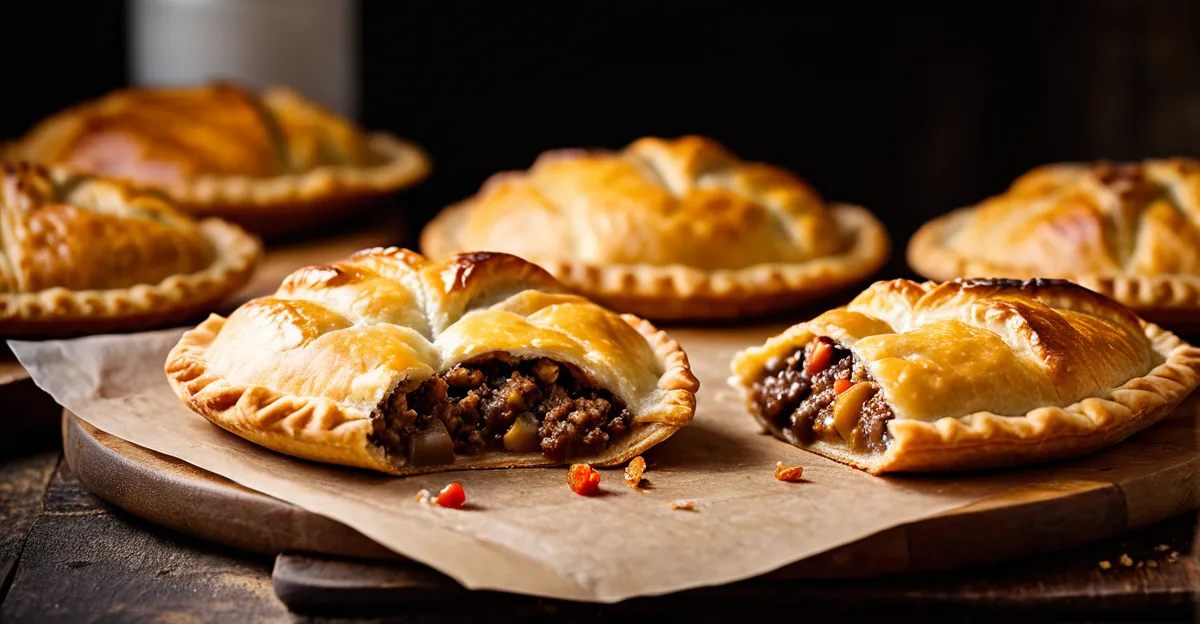Traditional Cornish Pasty Defined
The traditional Cornish pasty is a distinctive baked pastry celebrated for its specific shape, filling, and preparation. It originated as a convenient and hearty meal for miners in Cornwall, offering sustenance during long workdays. The pasty’s key features include a robust, crimped edge to hold the filling securely and a filling composed of simple yet authentic ingredients.
Central to its identity are the authentic ingredients: typically, beef skirt, potato, swede, and onion, all enveloped in a sturdy pastry dough. Each component plays an integral role; the beef provides richness, the root vegetables add texture and earthiness, and the pastry offers a satisfying crunch. Using these traditional ingredients ensures the pasty adheres to its cultural roots and flavour profile.
In the same genre : What are some innovative ways to serve a traditional Welsh rarebit?
The Cornish pasty history traces back to the 13th century, but it was in the 19th century mining industry that the pasty truly became iconic. Its design suited miners’ needs: the crimp acted as a handle, so hands could stay clean after eating. This pasty is now protected by Protected Geographical Indication (PGI) status, underscoring the importance of preserving its heritage through authentic preparation.
Essential Ingredients and Their Roles
Understanding the Cornish pasty ingredients is crucial for achieving an authentic traditional Cornish pasty. The filling relies heavily on the beef skirt, a cut prized for its rich flavour and tenderness after slow baking. It forms the meat base that complements the starchy and sweet notes of the vegetables. The choice of potato, swede (also known as rutabaga), and onion is deliberate—each contributes texture and balances the overall taste. Potatoes provide softness and bulk, swede adds a slightly sweet, earthy undertone, and onion imparts a subtle sharpness that enhances the meat.
Topic to read : How can you make a fluffy Yorkshire pudding?
Equally important is the pastry dough, which must be robust enough to hold the filling and create a crisp, golden crust. Traditional recipes favor a shortcrust pastry made with either butter, lard, or a mixture of both. Butter offers a rich flavour, while lard lends flakiness and strength, ensuring the pasty retains its shape during baking.
Achieving the perfect balance of these ingredients is key. The vegetable-to-meat ratio typically approximates to ensure the filling cooks evenly and the flavours meld satisfactorily. Excess liquid in the filling is avoided to prevent soggy pastry. Careful chopping of ingredients into uniform sizes allows consistent cooking, avoiding undercooked vegetables or a dry filling.
In summary, the integrity of the traditional Cornish pasty depends on selecting high-quality beef skirt, fresh root vegetables, and a suitably sturdy pastry dough. These Cornish pasty ingredients work in harmony to preserve the pasty’s classic taste and texture, honored through generations.
Step-by-Step Preparation Process
Understanding the Cornish pasty recipe is essential to replicate the dish’s authentic taste and texture. The process begins with making the pastry, which requires careful handling to achieve the ideal balance between flakiness and sturdiness. The dough is typically prepared using a combination of butter and lard, chilled thoroughly before rolling. This chilling step prevents the fat from melting prematurely, ensuring the pastry bakes to a crisp yet tender consistency.
Next, attention turns to assembling the filling. The traditional filling consists of diced beef skirt, potato, swede, and onion. Each ingredient must be chopped uniformly to promote even cooking. Seasoning is kept simple, usually just salt and pepper, allowing the quality of the authentic ingredients to shine through. Ensuring the filling is not overly wet is crucial; excess moisture can lead to a soggy pastry.
When assembling, the filling is placed centrally on the rolled-out pastry round, taking care not to overfill. The edges are then folded over and sealed by hand. Proper sealing is vital to prevent leakage during baking and to maintain the distinct pasty shape. The crimping technique not only secures the filling but also creates the traditional crescent form associated with the traditional Cornish pasty. Careful folding and pressing along the edge finalize the assembly, preparing the pasty for the subsequent baking stage.
Baking Instructions for Authentic Results
Achieving the perfect Cornish pasty bake starts with setting the appropriate oven temperature, typically around 190°C (375°F). Preheating the oven fully before placing pasties inside ensures even heat distribution, which is essential for a crisp, golden crust and thoroughly cooked filling. An insufficiently preheated oven can cause uneven baking, leading to either undercooked interiors or overly browned pastry.
Proper placement on the baking tray is crucial. Pasties should be spaced to allow hot air circulation and should be placed on a middle rack to avoid burning the base or top. To encourage steam release during baking, small vents or slits are made in the top pastry; this step helps prevent sogginess and maintains the pastry’s flaky texture.
Timing is equally important. The baking time for a traditional Cornish pasty usually ranges between 45 to 55 minutes. Monitoring for doneness involves observing a golden-brown crust and smelling the savory aroma of cooked beef and vegetables, which signals that the filling is properly cooked. Underbaking can result in doughy pastry and tough filling, while overbaking dries out the ingredients and hardens the crust.
These baking guidelines, when followed precisely, preserve the integrity of the authentic ingredients and honor the traditional Cornish pasty‘s reputation for robust flavour and texture.
Mastering the Traditional Crimping Technique
The traditional Cornish pasty crimp is a defining feature that not only secures the filling but also preserves its authentic appearance and ease of handling. Precise crimping protects the pasty during baking, preventing leakage of juices from the authentic ingredients like beef skirt, potato, swede, and onion. This sealing ensures the filling cooks evenly while maintaining the signature crescent shape valued in Cornish pasty history.
To achieve the perfect Cornish pasty crimp, start by folding the pastry over the filling, overlapping the edges evenly. Using your thumb and forefinger, pinch the edge at one end, then fold and press sequentially along the side to create a continuous, raised ridge. This technique forms a robust seal and distinguishes the traditional pasty from other pastries that may use simple pressing or fork marks. The tightness and consistency of the crimp also affect steam release and texture, contributing to an even bake.
Two main crimping styles exist: the classic side crimp, which runs along the curved edge, and the less common top crimp. The side crimp is authentic to Cornish tradition and allows the pasty to be held by the crimped edge—historically important for miners eating with dirty hands. Mastery of this method adds not only structural integrity but also a visual cue to distinguish a traditional Cornish pasty.
Proper crimping technique complements the filling and pastry dough, ensuring that the traditional Cornish pasty maintains its cultural significance and delivers its characteristic flavour and texture. Practicing this step with care preserves the craftsmanship embedded in Cornish pasty history, making it essential for any authentic recipe.
Common Mistakes and Troubleshooting Advice
When perfecting the traditional Cornish pasty, avoiding common Cornish pasty mistakes is essential for preserving the dish’s authentic flavour and texture. One frequent issue is soggy pastry, often caused by excess moisture in the filling. To prevent this, ensure that the chopped beef skirt, potato, swede, and onion are dry before assembly, and avoid overfilling. Proper drainage or lightly patting vegetables helps maintain a crisp crust during the Cornish pasty bake.
Leakage during baking typically results from inadequate sealing or an improperly executed Cornish pasty crimp. Ensuring the edges are firmly pressed and neatly crimped protects the filling’s juices and maintains the pasty’s structural integrity. If leakage persists, revisiting the crimping technique and confirming the pastry dough has the right consistency is advisable.
Overcooked fillings can arise from imbalanced oven temperature settings or prolonged baking times. Consistently preheating the oven to around 190°C (375°F) and monitoring the baking duration between 45 to 55 minutes helps avoid drying out the authentic ingredients. Placement on the baking tray also influences even cooking; placing pasties on the middle rack with enough space encourages uniform heat circulation.
Home ovens often vary in performance, so adapting baking times and monitoring visual cues—like a golden-brown crust and the aroma of cooked meat and vegetables—is key to achieving reliable results. Practicing these troubleshooting strategies ensures every traditional Cornish pasty honors its heritage and delivers satisfying flavour and texture.


